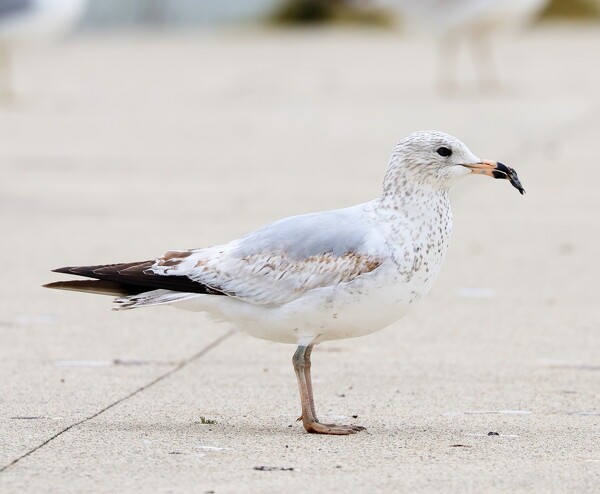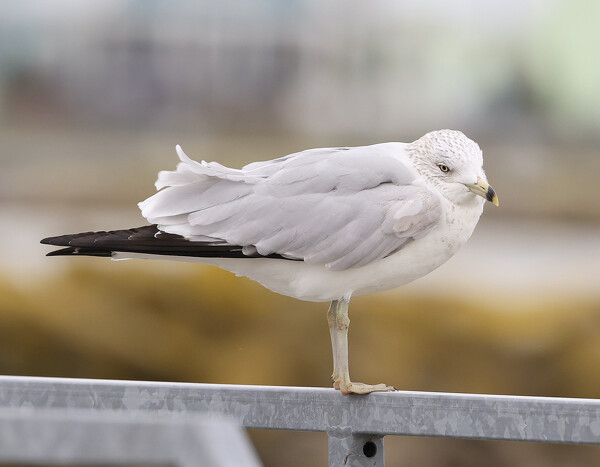
Some friendly and feathery Grand Lake locals play near the pier along Lake Shore Drive in Celina on Wednesday afternoon.
CELINA - Known for living in and around bodies of water, gulls have a naturally large presence in the Grand Lake region.
The water birds, known commonly as seagulls, are extremely common in some parts of the state, mostly near the Great Lakes and inland bodies of water, Ohio Department of Natural Resources Wildlife Communications Specialist Kathy Garza-Behr said.
Gulls feed on fish and amphibians, but they're also scavengers, Brett Beatty, ODNR wildlife management supervisor, said.

A seagull's diet consists of fish and amphibians.
"They frequent parking lots to roost as well as scavenge," Garza-Behr added. "The parking lots offer them trash that may contain food and the lots are also large and open. The open space allows them the ability to see predators or danger more easily."
It's also not uncommon to see some gulls in a freshly plowed field picking insects and grub out, Beatty added.
Large flocks of both herring and ring-billed gulls pop up on Grand Lake because the lake was built for the canal system in Ohio, said Sam Romeo, environmental educator at Aullwood Audubon, a non-profit ornithology society.
"Those birds are probably coming from Lake Erie; they're probably hopping around along the Great Lakes and (are) on their way down south because as the water freezes, they move farther south," Romeo said. "We think that they follow these rivers until they get into a warmer spot or find a big lake that doesn't freeze."

Ring-billed gull:
A medium-sized bird, similar in size to a crow, with a short, slim bill. The call is a commonly heard and familiar, drawn-out yelp.
The most common gulls seen around Grand Lake are ring-billed and herring gulls, he said. They are the two main gulls that breed in Ohio, per an ODNR field guide.
"You may get some other incidental (breeds) depending on weather and flight patterns, but those are the ones you're primarily going to see," Beatty said.
The ring-billed gull is a medium-sized bird, similar in size to a crow, with a short, slim bill, according to the Cornell Lab of Ornithology.

Some friendly and feathery Grand Lake locals play near the pier along Lake Shore Drive in Celina on Wednesday afternoon.
"When the gull perches, its long, slender wings extend well past its square-tipped tail," the website reads. "In flight, the birds move lightly on easy flaps of their fairly slender wings."
Although some ring-billed gulls live near coastlines, many spend most of their lives along inland waterways such as Grand Lake, per the American Bird Conservancy website. Ring-billed gulls take to fresh water as easily as salt water, and gulls can go their entire lives without dipping a foot in the sea.
Ring-billed birds have become much more tolerant to people, Beatty said.
"Ring-billed gulls are definitely more used to humans," Romeo said. "They nest around human structure sometimes."
Their call is a commonly heard and familiar, drawn-out yelp, per the ODNR field guide.
Larger than the ring-billed gull, the herring gull is sized between a crow and a goose, according to the Cornell Lab of Ornithology. Adult herrings have light-gray backs, black wingtips and white heads and underparts.
"In winter, dusky streaks mark their heads," per the American Bird Conservancy website. "Herring gulls take four years to reach adult plumage. Juveniles are mottled; second-year birds are brown but show gray on the back. Third-year birds have more gray on the back and more white on the head and underparts."
The species, like other large gulls, takes four years to obtain adult plumage, so young birds look quite different from adults, according to the ODNR field guide.
Herring gulls are one of the world's most widely distributed gulls, the field guide states. Ranging nearly worldwide in the Northern Hemisphere, the herring gull is most common along Lake Erie, however, small numbers can be found elsewhere in Ohio in flocks of ring-billed gulls.
"They're flying through the air, they're skimming the water, they're splashing down on the water to maybe get some food," Romeo said. "Those are probably going to be the herring gulls. Just because they are the more general kind of foraging birds."
The herring's call is a loud, clear bugling yelp that rises above the cries of ring-billed gulls, and they often give a softer three or four-note eh-eh-eh-eh call, according to the ODNR field guide.

